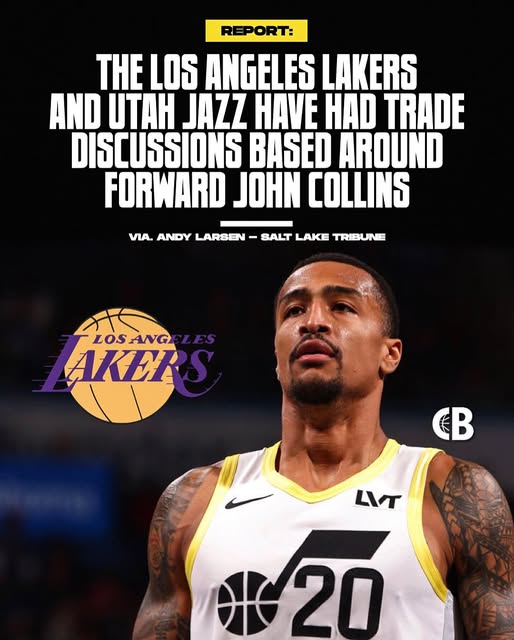The NBA offseason is always filled with speculation, rumors, and behind-the-scenes maneuvers as teams seek to improve their rosters and position themselves for championship contention. Recently, one of the most intriguing whispers swirling around the league involves the Los Angeles Lakers and the Utah Jazz engaging in trade talks centered on power forward John Collins. While the discussions are reportedly in the early stages, the mere possibility of such a move has sent shockwaves through the basketball community, raising questions about how this potential trade could reshape the futures of both franchises.
John Collins has established himself as one of the most dynamic forwards in the league. Since entering the NBA as a first-round pick, Collins has developed into a reliable scorer, rebounder, and rim protector with the kind of versatility that modern basketball demands. His ability to stretch the floor with a consistent three-point shot combined with his athleticism around the basket makes him a coveted asset for any team looking to enhance its frontcourt depth. For the Utah Jazz, Collins represents a potential key piece to bolster their lineup and complement their existing core of players, while for the Lakers, acquiring a player of Collins’ caliber could provide an injection of youth, energy, and scoring versatility that the team has long sought after.
The Lakers have been navigating a transitional period following the twilight years of their previous championship core. With LeBron James and Anthony Davis aging and battling injuries, the organization is seeking ways to inject fresh talent to stay competitive in the loaded Western Conference. John Collins fits the profile of a player who can bring athleticism and scoring punch while also being a relatively young piece with upside. Moreover, Collins’ ability to stretch the defense with his shooting and his rebounding prowess could ease the burden on Davis, allowing him to conserve energy and focus on defensive assignments.
From the Jazz perspective, there is an opportunity to shake things up after a few seasons of stability but without ultimate playoff success. Utah has a strong foundation, but the team has faced challenges in finding the right mix to push them deeper into the postseason. Adding a player like Collins would not only improve their frontline but also create new offensive possibilities. His skill set aligns with the modern NBA’s emphasis on spacing and versatility, traits that can help the Jazz counter some of the league’s more dominant teams. While the exact details of the proposed trade talks have not been disclosed publicly, the rumors alone suggest both teams see a strategic benefit in exploring this potential exchange.
Trade discussions in the NBA often start quietly, with teams feeling out interest and gauging potential fits before committing to a deal. The Lakers and Jazz are no strangers to making bold moves when the opportunity arises. Los Angeles, with its championship pedigree and high-profile roster, always has the incentive to be aggressive in pursuit of talent. Meanwhile, Utah has shown a willingness to adapt and make calculated changes to improve its roster continuity and playoff potential. If this trade were to come to fruition, it would mark a significant shift for both teams, signaling a readiness to embrace new directions.
One of the critical considerations in these talks will be the pieces each team might have to give up to make the trade happen. John Collins commands value, and any trade would likely require a combination of draft picks, young players, or role players who can provide immediate or future contributions. For the Lakers, shedding salary or moving players who no longer fit their long-term vision could be part of the equation. For Utah, finding assets that align with their timeline and development plans will be equally important. Balancing the financial and roster implications is always a challenging part of NBA trades, and this potential deal will be no different.
Another layer to this scenario is how John Collins himself fits into the culture and style of each team. The Lakers have a storied history of blending superstar talent with complementary pieces who can step up in big moments. Collins’ youth and energy could be an asset in the locker room and on the court, but it remains to be seen how his style meshes with the Lakers’ existing stars. On the other side, Utah’s structured system and emphasis on teamwork may offer Collins a different kind of role that could maximize his strengths. The player’s own preferences and openness to change will inevitably factor into any final decision.
This reported dialogue between the Lakers and Jazz around John Collins also highlights the ever-changing nature of the NBA landscape. Player movement has become more fluid than ever, with trades, free agency, and signings shaping the league’s balance of power each offseason. Teams are constantly searching for that elusive combination of talent, chemistry, and fit that can propel them to the highest levels of success. Moves like this potential trade can serve as a catalyst for renewed optimism or signal a broader rebuilding effort, depending on the perspectives of the franchises involved.
Fans and analysts alike will be watching closely as more information surfaces about these trade talks. The Lakers and Jazz both have passionate followings eager to see how their teams evolve and compete. If a deal involving John Collins comes to pass, it will be dissected for its impact on team dynamics, playoff prospects, and future flexibility. Conversely, if talks stall or fall apart, the speculation will only intensify, prompting discussions about alternative moves each team might pursue. Either way, this storyline is a compelling reminder of the strategic chess match that defines NBA front offices.
Looking beyond just the immediate implications, the potential trade also speaks to the broader trends in the NBA regarding player roles and frontcourt value. The league has seen a shift toward versatile forwards who can do a little bit of everything—score, defend multiple positions, rebound, and shoot from distance. John Collins embodies this archetype, making him a valuable commodity in today’s game. Teams that recognize this and move quickly to acquire such talent often gain a competitive edge, especially when playoff positioning and seeding come into play.
The Lakers, in particular, have struggled in recent seasons to find consistent secondary scoring and reliable frontcourt options aside from their stars. Adding a player like Collins could alleviate some of those issues and provide a different look offensively. For Utah, which has relied on a balanced attack and strong defense, Collins could offer a new wrinkle to their approach, creating mismatches and opening up the floor for their shooters and guards. Both teams stand to gain strategically if the trade negotiations lead to a deal.
While details remain sparse, the conversation itself is noteworthy in the context of the upcoming NBA season. Both franchises are eager to make moves that will keep them relevant and competitive. The Lakers’ pursuit of a player like John Collins aligns with their desire to reassert themselves as title contenders, while the Jazz’s interest suggests a willingness to tweak their roster to reach the next level. The outcome of these talks will be closely monitored by insiders and fans, as it could set a tone for further offseason activity.
In conclusion, the reported trade discussions between the Los Angeles Lakers and Utah Jazz centered on John Collins present a fascinating development in the NBA offseason landscape. Collins’ talent and versatility make him an appealing asset for both teams, each with distinct motivations for pursuing the deal. While the specifics of what might be exchanged remain under wraps, the potential trade underscores the fluid nature of roster building in today’s league. Whether or not this deal ultimately comes to fruition, it serves as a reminder that in the NBA, change is constant, and every move carries the potential to reshape the competitive balance and rewrite team narratives. As the offseason progresses, all eyes will remain on these two storied franchises and the evolving story of John Collins’ next chapter in the league.



